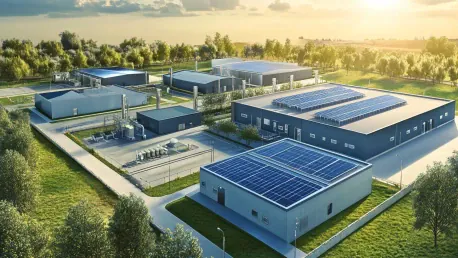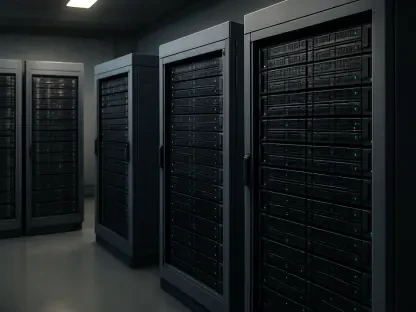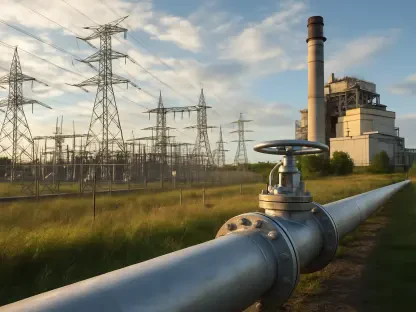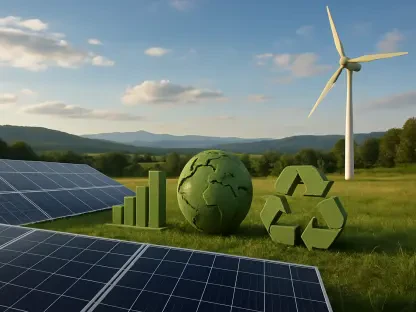The integration of renewable energy sources and the rising popularity of electric vehicles are adding more strain to the main grid, making reliability a primary concern, especially in remote areas or regions prone to natural disasters. Recent extreme weather events have exposed significant vulnerabilities in our current grid system, underscoring the need for a more resilient infrastructure. As the demand for electricity continues to grow, particularly in electrified transportation and renewable energy projects, traditional grids are finding it increasingly challenging to keep up. This growing strain has sparked interest in innovative solutions to ensure a consistent and reliable power supply, leading to the rise of microgrids as a viable alternative.
The Growing Challenges of the Power Grid
The increasing demand for electricity, coupled with aging infrastructure and the rise of renewable energy sources, is straining the power grid. Many regions face frequent blackouts and reliability issues. Upgrading and modernizing the grid is essential to meet future energy needs and ensure a stable supply.
Impact of Extreme Weather Events
Extreme weather events have become increasingly frequent and severe due to climate change. These events significantly impact communities, economies, and ecosystems. Floods, hurricanes, and wildfires cause widespread damage, displace populations, and interrupt daily life. Additionally, they strain resources, disrupt supply chains, and lead to substantial economic losses. Consequently, it is crucial to develop effective strategies for mitigation and adaptation to safeguard both human and environmental well-being.
The devastating effects of storms like Helene and Milton have highlighted the critical need for a more robust and reliable power grid infrastructure. These recent storms caused widespread power outages, leaving millions without electricity for extended periods and exposing the inherent weaknesses of our current grid system. Extreme weather events, including hurricanes, heavy snowfall, and torrential rain, are becoming more frequent and intense due to climate change, further amplifying the grid’s vulnerabilities. As a result, the traditional centralized grid model is increasingly unable to cope with the mounting challenges posed by natural disasters, necessitating the exploration of alternative solutions.
The consequences of these power outages extend beyond mere inconvenience; they can have dire economic and social implications. Businesses faced with prolonged disruptions may suffer significant financial losses, while hospitals and other critical infrastructure risk operational failures that could put lives at stake. In remote and disaster-prone areas, the reliance on a centralized grid becomes particularly precarious. Without a reliable contingency plan, communities may find themselves isolated and powerless in the wake of a catastrophic event. Addressing these challenges requires a more resilient and adaptable power infrastructure capable of withstanding the unpredictable forces of nature.
Increasing Electrification Demands
The rise in global electrification demands has been driven by various factors, including the transition to renewable energy sources, the proliferation of electric vehicles, and the increasing reliance on electronic devices. As countries strive to reduce carbon emissions and achieve sustainability goals, the demand for electricity continues to grow. This trend underscores the need for significant investments in energy infrastructure, grid modernization, and efficient energy storage solutions to ensure a reliable and resilient electricity supply for the future.
Simultaneously, the growing adoption of electric vehicles (EVs) and the integration of renewable energy resources are imposing additional strains on the existing power grid. With the shift toward greener transportation and a sustainable energy future, more people are transitioning to EVs, which demand significant amounts of electricity. Charging these vehicles, especially during peak hours, can surge demand and overload the current grid infrastructure. This increased load further complicates an already stressed system, exacerbating the risk of power outages and reliability issues, particularly in regions where the grid is less robust.
Furthermore, the rise of renewable energy sources such as solar and wind power introduces another layer of complexity. These distributed energy resources, while environmentally friendly, produce electricity intermittently, depending on weather conditions and time of day. Integrating such unpredictable power sources into the grid requires advanced management techniques and technologies to balance supply and demand effectively. If not carefully managed, the variability of renewable energy generation can lead to grid instability, making it challenging to maintain a reliable and continuous power supply. As electrification demands grow alongside the adoption of renewable energy, the importance of ensuring a stable and resilient grid infrastructure becomes ever more critical.
Microgrids as a Viable Alternative
Self-Sustaining Power Systems
In response to the mounting challenges faced by the traditional power grid, microgrids have emerged as a promising solution. These self-sustaining power systems can operate independently from the main grid, providing a reliable, flexible, and energy-independent alternative. Microgrids enable localized generation and distribution of electricity, ensuring uninterrupted power supply during grid outages or in remote regions where connectivity to the main grid may be unreliable. By harnessing local energy resources and operating autonomously when required, microgrids offer a resilient and adaptable approach to power distribution.
The ability of microgrids to function independently of the main grid also brings numerous advantages in terms of energy security and reliability. During natural disasters or other disruptive events, microgrids can isolate themselves from the central grid, continuing to supply power to critical facilities and communities. This capability is particularly valuable in remote areas where power disruptions are frequent and prolonged, providing a lifeline and mitigating the adverse impacts of such events. By offering localized control over generation and distribution, microgrids enhance grid resilience and empower communities to manage their own energy needs effectively.
Integration of Distributed Energy Resources
In the rapidly evolving energy landscape, the integration of distributed energy resources (DERs) such as solar panels, wind turbines, and battery storage systems is becoming increasingly vital. These resources help to create a more resilient and sustainable energy grid by decentralizing power generation and reducing reliance on traditional fossil fuel-based power plants. However, integrating these diverse and often intermittent energy sources poses significant challenges for grid stability, management, and regulation. Effective integration requires advanced technologies, including smart grids and real-time monitoring systems, as well as supportive policies and regulatory frameworks to encourage their adoption and ensure their efficient operation. By embracing DERs, we can move towards a cleaner, more reliable, and adaptable energy future.
Another significant benefit of microgrids lies in their ability to facilitate the integration of distributed energy resources (DERs) such as solar panels, wind turbines, and battery storage systems. By incorporating these renewable technologies, microgrids contribute to the growing trend toward cleaner and more sustainable energy solutions. DERs allow microgrids to generate power locally, reducing dependence on fossil fuels and lowering carbon footprints. Additionally, they offer a means to diversify energy sources, ensuring a more resilient and reliable power supply.
The deployment of DERs within microgrids also presents opportunities for optimizing energy usage and efficiency. By utilizing advanced management systems, microgrids can dynamically balance supply and demand, seamlessly integrating renewable generation with battery storage to match consumption patterns. This capability not only maximizes the benefits of renewable energy but also minimizes waste and reduces overall energy costs. For utilities, the adoption of microgrids with integrated DERs enables better management of the increasing penetration of renewable technologies within the broader energy landscape, helping achieve sustainability goals and reducing environmental impacts.
Beyond Backup Power: Dual Functionality of Microgrids
Reliability and Grid Services
While microgrids primarily ensure reliability during outages by operating autonomously, their value proposition extends beyond mere backup power solutions. When connected to the main grid, microgrids can provide valuable services such as grid support, capacity, resource adequacy, and energy balancing. During their typical operation, microgrids can switch seamlessly between island mode (self-sufficient operation) and grid-connected mode, participating in broader energy markets and contributing to overall grid stability. This dual functionality makes microgrids an appealing option for both commercial and residential users seeking enhanced reliability and additional benefits.
The ability of microgrids to offer grid services underscores their potential to play a pivotal role in modernizing and optimizing power grid operations. For example, during peak demand periods or times of grid stress, microgrids can supply excess power back to the main grid, alleviating the burden on central infrastructure and preventing potential outages. Moreover, by actively monitoring and managing energy flows, microgrids can support frequency regulation and voltage control, enhancing overall grid performance. This symbiotic relationship between microgrids and the main grid fosters a more flexible and resilient energy ecosystem, capable of adapting to evolving demands and challenges.
Economic Benefits for Businesses
Beyond their technical advantages, microgrids represent a sound investment for businesses, offering compelling economic benefits. By reducing reliance on the central grid and minimizing downtime during power outages, microgrids can save enterprises millions in avoided operational losses. Moreover, businesses can leverage microgrids to generate additional revenue by providing grid services, such as demand response or participating in capacity markets, further enhancing the financial appeal of adopting microgrid solutions. This dual functionality of microgrids not only ensures operational continuity but also opens up new avenues for profitability.
For commercial and industrial entities, the economic case for microgrids is particularly strong. Manufacturing facilities, data centers, and critical infrastructure like hospitals can benefit immensely from a stable and reliable power supply. By investing in microgrids, these businesses mitigate the risks associated with grid outages and disruptions, safeguarding their operations and ensuring continuous service delivery. Additionally, microgrids can provide a competitive edge by enhancing sustainability efforts and demonstrating a commitment to environmental responsibility, appealing to environmentally conscious customers and investors. The economic advantages, coupled with improved reliability and sustainability, make microgrids a valuable asset for a wide range of stakeholders.
Regional Implementation and Market Participation
Historical Use and Business Case
Fixed version:
Microgrids have a rich history of adoption in various forms, serving diverse needs and applications. From powering remote cabins in off-grid locations to ensuring reliability for critical infrastructure like hospitals, military bases, and college campuses, microgrids have proven their versatility and effectiveness. Their ability to operate independently and provide localized energy solutions has made them indispensable in regions facing reliability challenges or prone to natural disasters. The business case for microgrids is particularly compelling in these areas, where ensuring continuous power supply is paramount for safety and economic stability.
Historically, microgrid implementation has been highly customized to suit specific use cases and requirements. This tailored approach, while effective, has also posed challenges in terms of scalability and standardization. Each microgrid installation often involves unique design considerations, site-specific engineering, and bespoke solutions, resulting in high upfront costs and complexity. Despite these challenges, the proven benefits and successful deployment of microgrids in various scenarios have fueled ongoing interest and investment. The evolving energy landscape and increasing demand for reliable and resilient power solutions further underscore the significance of microgrids as a viable and strategic energy solution.
Scalability and Standardization
To realize the full potential of microgrids and make them more accessible and cost-effective, the industry is moving towards greater standardization and scalability. Efforts to develop pre-packaged, pre-tested microgrid solutions designed for specific use cases aim to streamline implementation and reduce costs. Standardized microgrid components, coupled with modular designs, enable faster deployment and easier replication across different regions and applications. By adopting a more uniform approach, the industry can overcome the barriers posed by bespoke solutions and make microgrids a mainstream option for various stakeholders.
The transition towards standardization also brings benefits in terms of economic viability and market participation. Streamlined implementation processes lower installation costs, making microgrids more affordable for businesses and communities. Additionally, standardized microgrid solutions can more readily integrate with existing infrastructure and participate in broader energy markets. This market integration allows microgrid owners to capitalize on revenue opportunities, such as providing ancillary services or participating in demand response programs. As standardization efforts progress, microgrids are poised to become an increasingly attractive and practical solution, addressing both technical and economic challenges in modern energy distribution.
Economic Viability and Market Conditions
Factors Influencing Payback Periods
The economic viability of microgrids varies significantly based on location, market conditions, and regional factors. One of the key determinants is electricity prices, which can influence the payback period and return on investment (ROI) for microgrid installations. Regions with high electricity costs stand to benefit more from microgrids, as the potential savings from reduced reliance on the central grid can offset the initial investment more quickly. Additionally, regions offering renewable energy incentives or subsidies can further enhance the economic appeal of adopting microgrids by lowering overall project costs and accelerating payback periods.
Another critical factor influencing the economic viability of microgrids is grid reliability. In areas with frequent outages or grid instability, the value proposition of microgrids becomes more pronounced. The ability to ensure continuous power supply during disruptions can translate into substantial cost savings by avoiding operational losses and downtime. Conversely, in regions with highly reliable grid infrastructure, the financial rationale for microgrids may require additional considerations such as environmental benefits or participation in energy markets. Ultimately, the economic feasibility of microgrids is contingent on a complex interplay of regional conditions, policy frameworks, and market dynamics.
Innovative Utility Programs
To enhance the attractiveness and economic viability of microgrids, some utilities have developed innovative programs that facilitate market participation for microgrid owners. One such initiative involves the concept of virtual power plants (VPPs), where multiple microgrid systems are aggregated to function as a single entity within the broader energy market. This aggregation enables microgrid owners to collectively bid into capacity markets, offer demand response services, and provide ancillary grid support. By participating in VPPs, microgrid owners can tap into additional revenue streams, making their investments more financially rewarding.
These utility programs represent a progressive approach to integrating microgrids into the broader energy ecosystem. By fostering collaboration and market participation, they align the interests of microgrid owners and utilities, creating a synergy that benefits all parties involved. VPPs and similar initiatives also contribute to overall grid resilience by leveraging distributed energy resources to support grid stability and efficiency. As these programs gain traction, they pave the way for more widespread adoption of microgrids, promoting economic viability while enhancing grid performance and sustainability. Innovative utility programs thus play a pivotal role in advancing the microgrid industry and fostering a resilient, market-driven energy landscape.
Enhancing Grid Resilience and Integrating Renewables
Role of Distributed Energy Resource Management Systems (DERMS)
Distributed Energy Resource Management Systems (DERMS) are crucial for the effective operation and integration of microgrids with the broader power grid. DERMS enable real-time monitoring, control, and optimization of distributed energy resources, ensuring that microgrids can contribute positively to overall grid stability and performance. By intelligently managing the various elements within a microgrid, including renewable generation, battery storage, and load demands, DERMS facilitate seamless coordination and responsiveness to changing grid conditions.
The deployment of DERMS within microgrids allows for advanced functionalities such as load balancing, peak shaving, and demand response. These capabilities enhance the ability of microgrids to provide valuable grid services, supporting frequency regulation, voltage control, and other ancillary services. Moreover, DERMS enable proactive management of renewable energy generation, optimizing the use of intermittent sources like solar and wind. By integrating these advanced management systems, microgrids can achieve higher levels of efficiency, reliability, and sustainability, making them a critical component of modern energy infrastructure.
Smart Meters and Edge Computing
In conjunction with DERMS, smart meters with distributed intelligence (DI) and edge computing capabilities play a pivotal role in the operation and integration of microgrids. Smart meters provide real-time data on energy consumption, generation, and grid conditions, enabling precise and dynamic management of microgrid operations. With embedded intelligence and edge computing, these meters can analyze data locally, make autonomous decisions, and respond quickly to fluctuations in energy supply and demand. This distributed intelligence enhances the ability of microgrids to adapt to changing conditions and maintain optimal performance.
The integration of smart meters and edge computing within microgrids also supports advanced functionalities such as fault detection, predictive maintenance, and automated demand response. By continuously monitoring the health and performance of microgrid components, these technologies can identify potential issues before they escalate, ensuring a reliable and uninterrupted power supply. Additionally, the autonomous response capabilities of edge computing facilitate rapid adjustments to maintain grid stability and balance. These technological advancements are essential for the seamless integration of microgrids with the main grid, optimizing energy usage and enhancing overall grid resilience.
Future Innovations and Market Pressure
Pre-Packaged Microgrid Solutions
Looking forward, future innovations in microgrids are centered around the development of pre-packaged, pre-tested solutions targeted at specific use cases. These pre-configured microgrid systems are designed to simplify implementation, reduce costs, and enhance scalability. By leveraging distributed intelligence and advanced automation, these solutions enable local control and seamless integration with the main grid. Pre-packaged microgrids offer flexibility and adaptability, allowing them to be customized to meet a variety of needs, from residential and commercial applications to industrial and critical infrastructure.
The introduction of pre-packaged microgrid solutions marks a significant step toward mainstream adoption and broader market acceptance. By providing standardized, reliable, and cost-effective options, these products lower the barriers to entry for potential users. Businesses, communities, and utilities can more readily deploy microgrids without the need for extensive engineering and customization, accelerating the transition to resilient and distributed energy systems. As these innovations continue to evolve, they are expected to drive increased adoption of microgrids, fundamentally reshaping the landscape of energy distribution and management.
Impact of Major Companies
The growing interest in microgrids is not limited to utility companies and small-scale users; major corporations are also recognizing their potential. Companies like Amazon are taking the initiative to deploy their own microgrids independently, circumventing the need for utility-approved grid connections. This trend is particularly evident in large-scale facilities like distribution centers, where the demand for reliable power is critical. By implementing microgrids for their operations, these companies can ensure uninterrupted energy supply, reduce operational costs, and achieve sustainability goals. This shift towards self-generated power solutions is creating market pressure and driving regulatory considerations.
The actions of major companies deploying independent microgrids are influencing the broader energy market, compelling regulators and utilities to reassess their strategies and business models. The potential loss of high-value customers to self-sufficient microgrid solutions has far-reaching implications, prompting a re-evaluation of costs, incentives, and policies. This evolving dynamic underscores the transformative impact microgrids can have on the energy landscape, challenging traditional utility models and fostering innovation. As more companies adopt microgrid technology, the market pressure is likely to accelerate the development of more flexible and customer-centric energy solutions, paving the way for a more resilient and sustainable future.
The Role of Microgrids in Modern Utility Operations
Uninterrupted Power Supply
Microgrids have become an indispensable element of modern utility operations, offering a robust solution to ensure uninterrupted power supply during grid outages. By isolating from the main grid and operating autonomously, microgrids provide a reliable and continuous power source, safeguarding critical infrastructure and essential services. This capability is particularly vital in regions prone to natural disasters or frequent power disruptions, where traditional grid infrastructure may be insufficient to meet reliability needs. Microgrids enhance grid resilience by providing localized energy solutions, mitigating the impact of outages, and ensuring continuity of operations.
The strategic deployment of microgrids also supports utilities in optimizing energy distribution and enhancing grid stability. By managing energy generation and consumption at a local level, microgrids contribute to efficient load balancing and reduce the strain on central grid infrastructure. This localized management of energy resources enables utilities to respond more effectively to fluctuations in demand and supply, maintaining grid performance even under challenging conditions. In the evolving energy landscape, where the integration of renewable sources and electrification demands are increasing, microgrids play a critical role in modernizing utility operations and ensuring a resilient and reliable power grid.
Meeting Consumer Demands
The integration of renewable energy sources and the growing popularity of electric vehicles are putting additional pressure on the main grid, making reliability a significant concern, especially in remote areas or regions susceptible to natural disasters. Recent extreme weather events have highlighted major weaknesses in our current grid system, emphasizing the need for a stronger, more resilient infrastructure. As the demand for electricity keeps rising, particularly from the electrification of transportation and renewable energy projects, traditional grids are finding it increasingly challenging to keep up. This increasing strain has sparked interest in innovative solutions to ensure a consistent and reliable power supply. One promising solution is the development of microgrids, which are being recognized as a viable alternative. These smaller, localized grids can operate independently or in conjunction with the main grid, providing a more reliable and flexible energy supply, especially in areas where the main grid falls short.









